If you have longed to try making homemade gluten free bread, I have a really simple recipe you will love! This gluten free bread machine bread is light and fluffy and has the perfect texture for sandwiches. If you don’t have a bread machine, don’t worry because I include oven-baking instructions too!
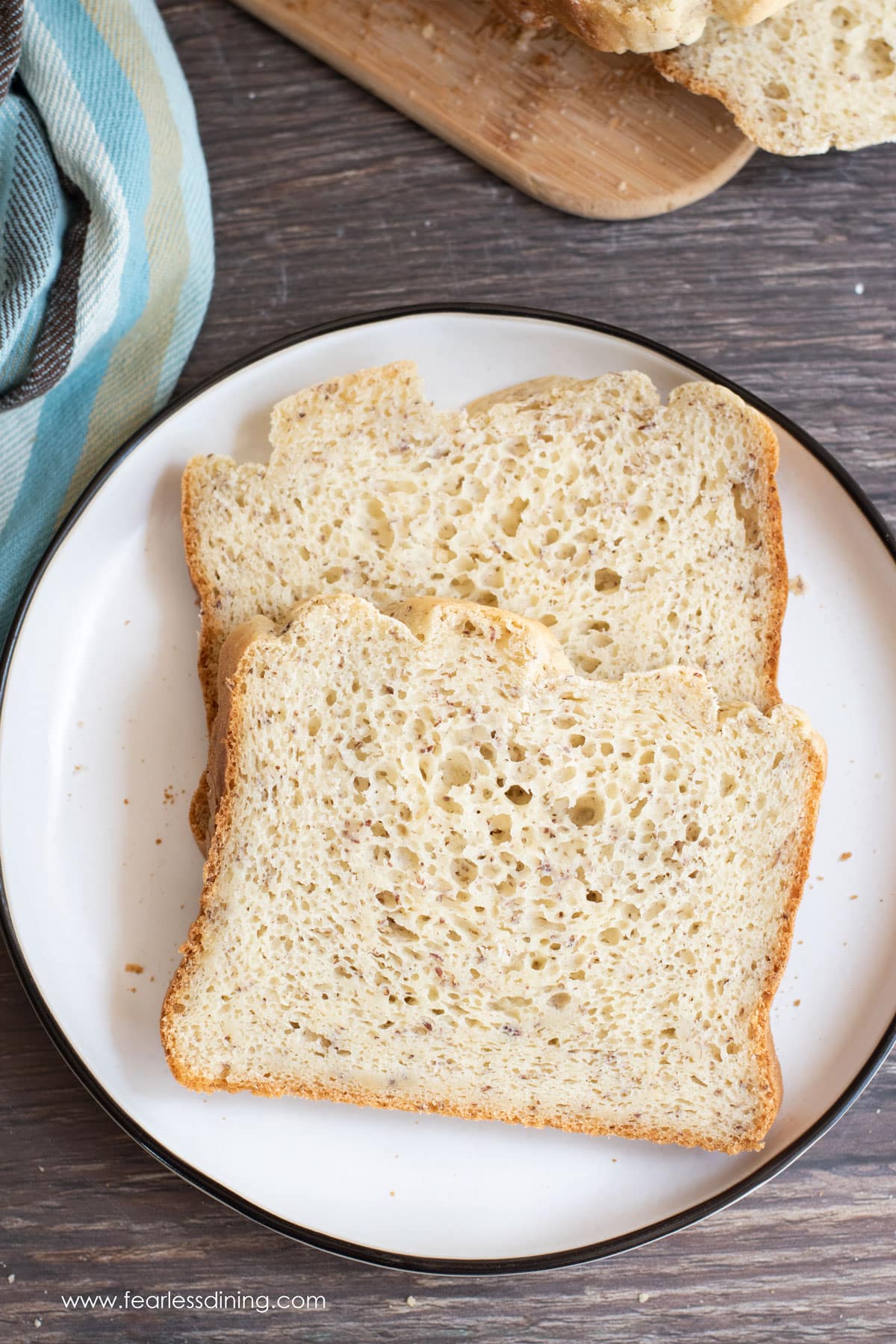
This is the best gluten free bread machine bread you will try! It is soft, and it sort of tastes like Wonder Bread. Do you remember Wonder Bread from way back before going gluten free? That bread was my favorite growing up. I didn’t know gluten was like poison to my body at that point in my life.
Recipe At A Glance:
Allergen Information:
This homemade bread machine bread recipe is gluten-free, dairy-free, nut-free, and soy-free. As mentioned below in the Reader Rave, you can make this bread egg-free using the Just Egg brand egg replacer. Make it gum-free using my DIY Gluten-Free Flour Blend.
While you are visiting, you may want to check out all of my delicious gluten free bread recipes!
Reader Raves
Made this recipe in my bread maker using Just egg substitute, and it came out AMAZING!! Thank you so much for making a gluten free bread that finally tastes delicious and holds up when using it to make sandwiches. We will continue to make this bread and refer it to others searching for a great gluten free tasting bread. You’re the best!” Mia K., Facebook comment
Thank you for coming up with this seriously easy, no-fail recipe. My wheat-eating husband said it’s his favorite bread ever, including regular gluten bread.” Angela H., Facebook comment
Why I love this gluten free bread machine bread recipe:
- I love this new bread recipe because it boils down to control. I can control the ingredients that go into this recipe with sorghum flour, and I realize that baking gluten free bread isn’t that hard.
- It is gluten free, dairy-free, soy-free, and corn-free! You can also use Just Egg to make this recipe egg-free.
- My secret to making the gluten free bread flour mix is to use more starch than usual. It keeps the bread fluffy and light. If you have been looking for that perfect sandwich bread, this is it!
- You can make it in the oven if you do not own a bread machine!
If you love sourdough, my loaf-style gluten free sourdough bread is really good too! If you want something sweeter, this gluten free lemon poppy seed bread is delicious.
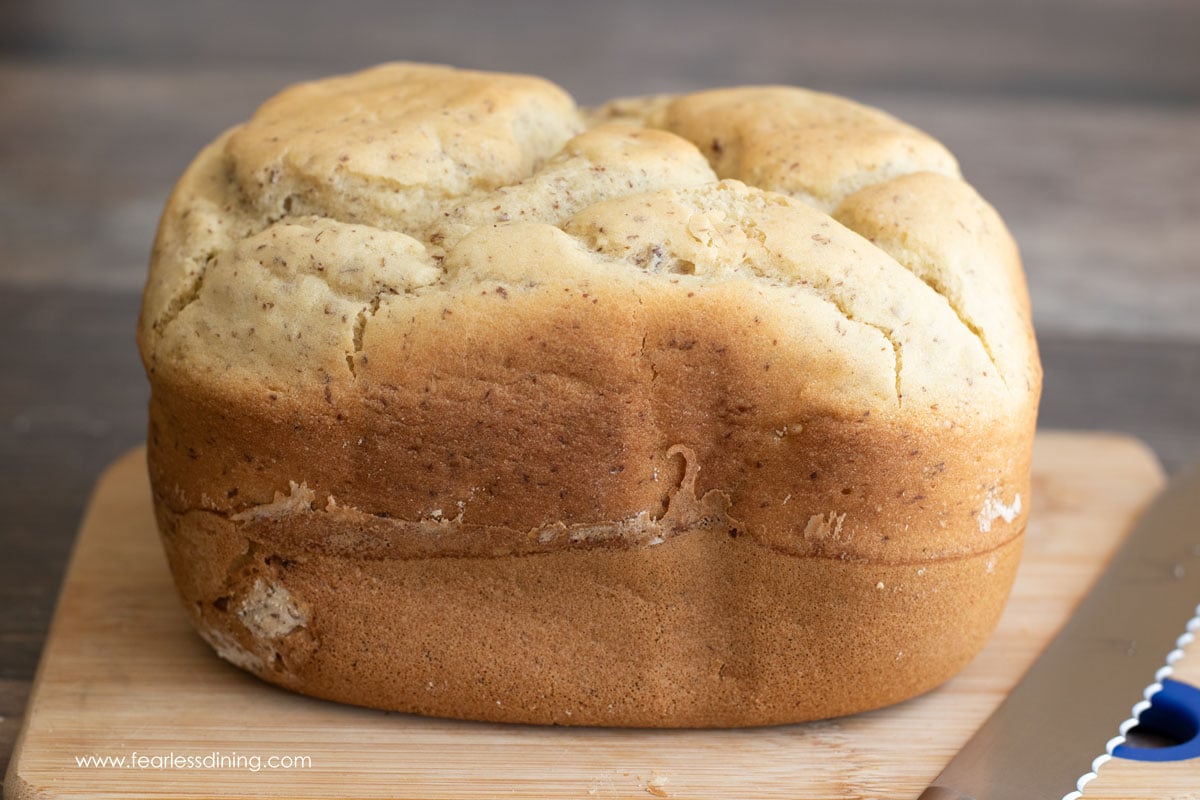
If you need a yeast-free bread recipe, try this Gluten Free Bread (No Yeast!)
Ingredient Notes:
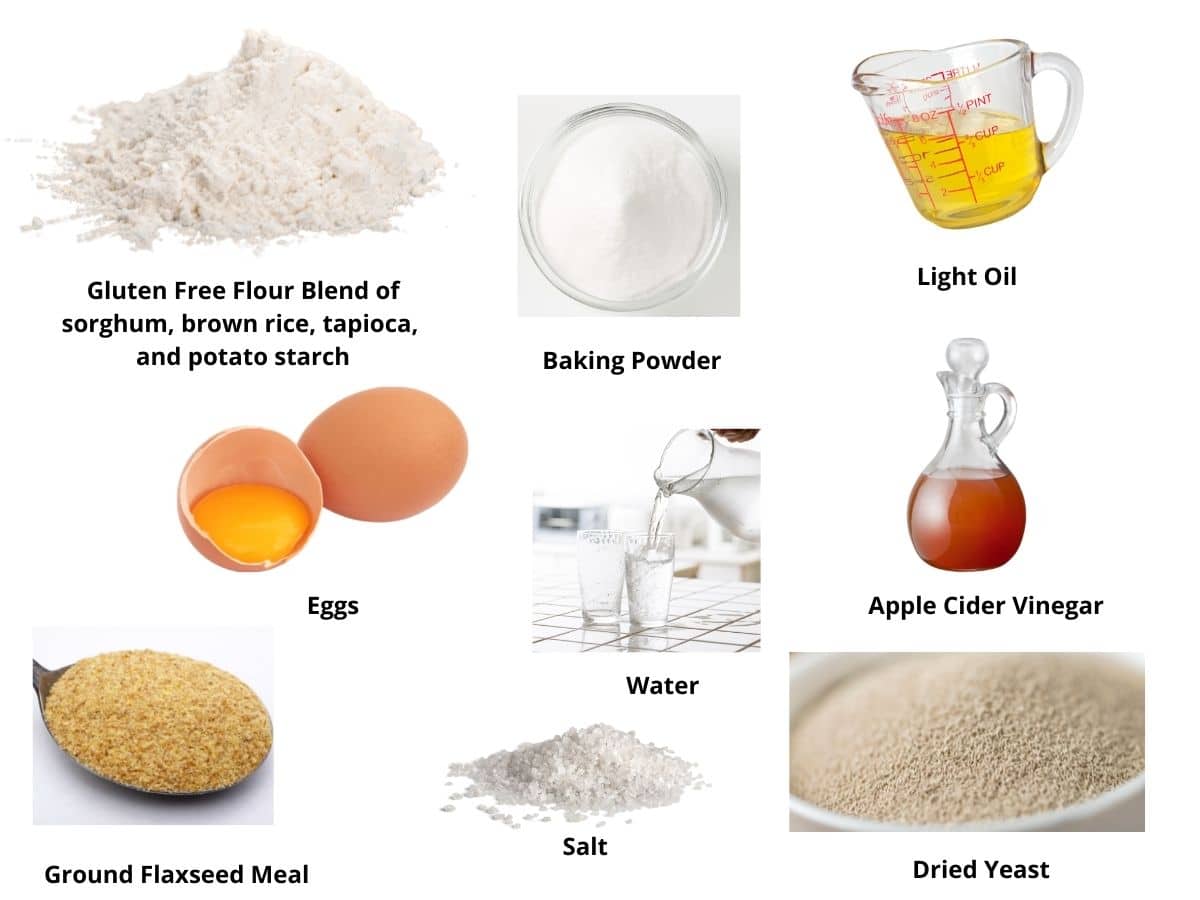
- Gluten Free Flour Blend – I tested a few gluten free blends in my bread machine. I highly advise using my custom gluten-free bread flour blend or Cup4Cup for this recipe. You will need sorghum flour, brown rice flour, tapioca, and potato starch. See the FAQ to see what modifications you need if using Cup4Cup! Note my DIY Gluten Free All Purpose Flour Blend works very well in this recipe. It is gum-free.
- Flaxseed Meal – I recommend using a ground flaxseed meal. Do not use whole seeds. You can read more about how to make sure flaxseed is gluten free.
- Eggs – Use size large.
- Apple Cider Vinegar – This gives a little flavor and helps the bread poof up.
- Baking Powder – I use this to help give more rise. Use aluminum-free baking powder.
- Sugar – I use a couple of tablespoons to help the yeast activate.
- Salt – Use either sea salt or kosher salt.
- Yeast – I used active dry yeast. I have not tested rapid yeast. ALWAYS double-check the label to ensure your yeast brand is gluten free. (Note: Red Star Platinum Yeast is NOT gluten free!)
Why Water Quality Is Important:
I always use purified water when making sourdough or baking with yeast. Chlorine and chemicals in our tap water can kill your yeast and inhibit the rise. If you want the best rise, you must use purified water that doesn’t contain these chemicals.
This is the gluten free bread machine that I use. I had a really old Breadman machine, but after 10 years it died, and I found this Hamilton Beach machine. It works really well. I do wish it had a longer bake cycle to get the top of the bread slightly darker, but otherwise it works perfectly.
Tips For Using A Breadmaker:
Before I go into the recipe steps, I want to discuss breadmakers. This recipe depends on the bread machine you use and the cycle type you run. The gluten free time/cycle settings differ on EVERY machine and model number. I am not sure why this is, but I am noticing it. Here are things I noticed and some ideas to make your machine work in this recipe:
- If you are at a high altitude, your yeast may be much more explosive than at typical altitudes. I do not live at a high altitude, and I do not know what to do about this except to use less yeast and bake this bread in the oven.
- Some breadmakers do not have a gluten free cycle, or the cycle isn’t long enough. If this is the case, use the “Home Made” custom cycle, programming in about 20 minutes Mix, 45 minutes Rise, 90 minutes Bake.
- Often, the gluten free setting does not bake the bread long enough. If this happens, you can run a short “bake-only” cycle to brown the bread more.
Also, please read my post on Gluten Free Bread Troubleshooting for more tips and my top recommendations for the Best Gluten Free Bread Making Tools.
Recipe Step-By-Step Directions:
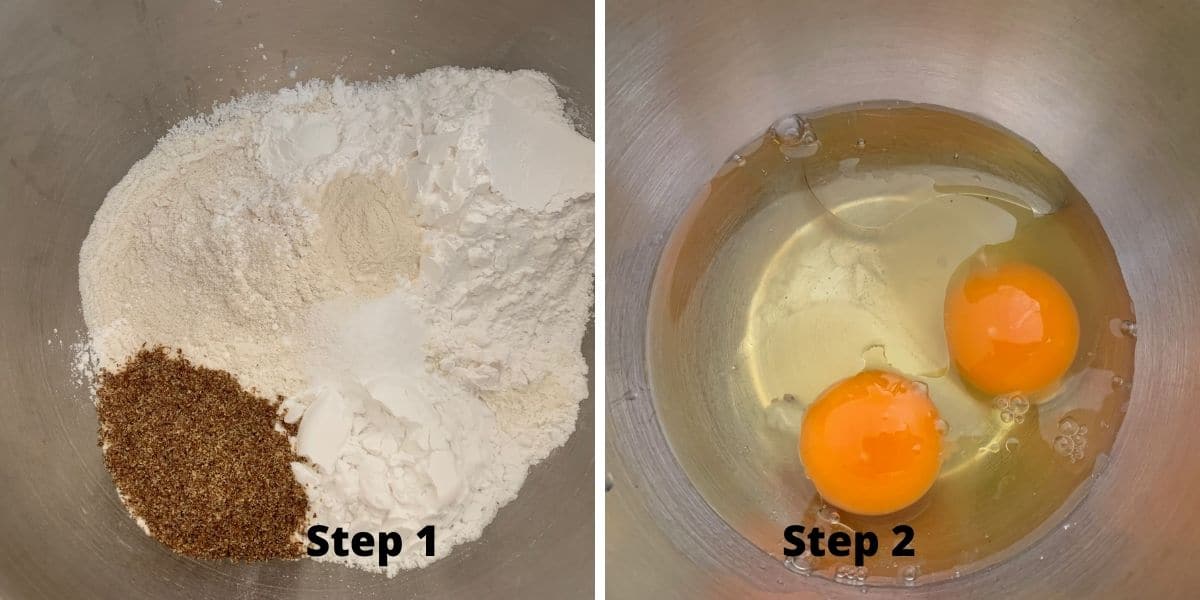
Step 1: Add the dry ingredients, including the flour and starches, baking powder, ground flaxseed meal, salt, and to a large
Step 2: Combine the wet ingredients and blend in a smaller bowl.
🔑 Sandi says: I have you blend the dry ingredients before adding them to your bread maker. Many bread recipe directions say you can dump all ingredients in the bread maker. Do not do this! When mixing many flour types, as are needed for gluten-free bread, you risk the ingredients not getting mixed thoroughly, which can affect how the bread turns out!
I now realize I’d forgotten the taste and texture of really good bread. Thank you for returning that pleasure to me.”
Lou J., Facebook comment
Best Gluten Free Flour For The Bread Machine
There are so many good gluten-free flour blends, and I tried a few while developing my recipe. Most didn’t perform well, so I created my own blend. I chose sorghum flour, brown rice flour, tapioca starch, potato starch, and ground flaxseed meal.
This combination of gluten free flours yielded the best results by far. This bread is a good gluten free sandwich bread. It holds up to peanut butter and jelly and a full lunchbox without breaking! The flavor and mouthfeel of the bread are light and fluffy.
NOTE: After two people reached out, I want to re-emphasize this recipe works with my custom flour blend or Cup4Cup, with a few modifications. See the FAQ for the modifications. Bob’s 1 to 1 and King Arthur Measure for Measure are not as good for yeast recipes.
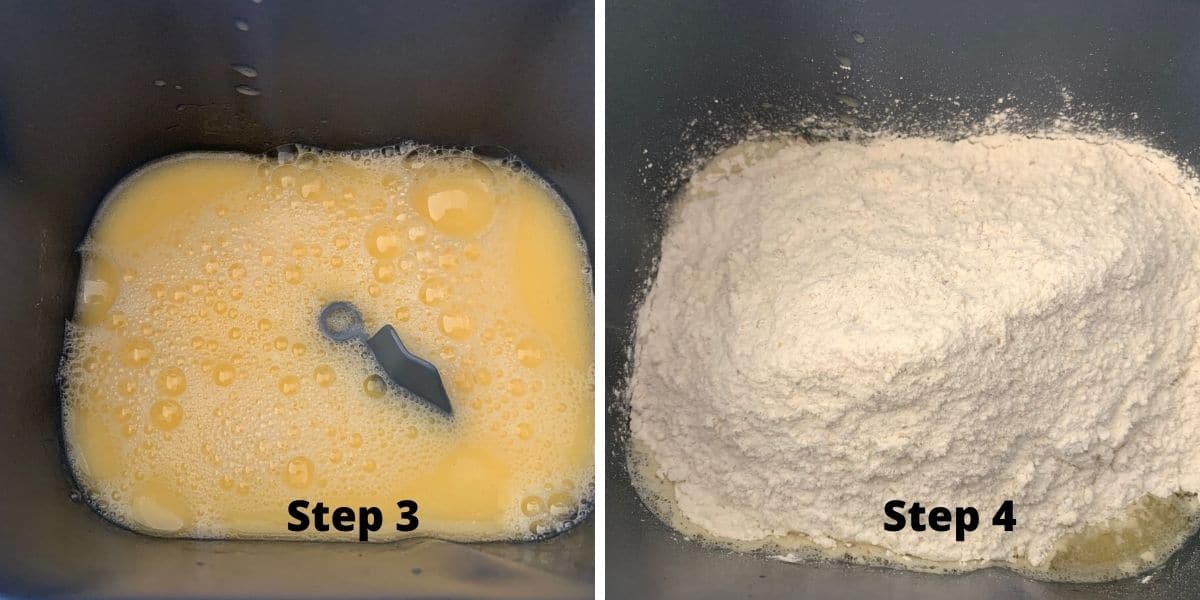
Step 3: Open your bread machine and make sure the paddle is on the spinner at the bottom of the bread maker. Pour in your mixed wet ingredients.
Step 4: Pour the whisked dry ingredients on top of the wet ingredients.
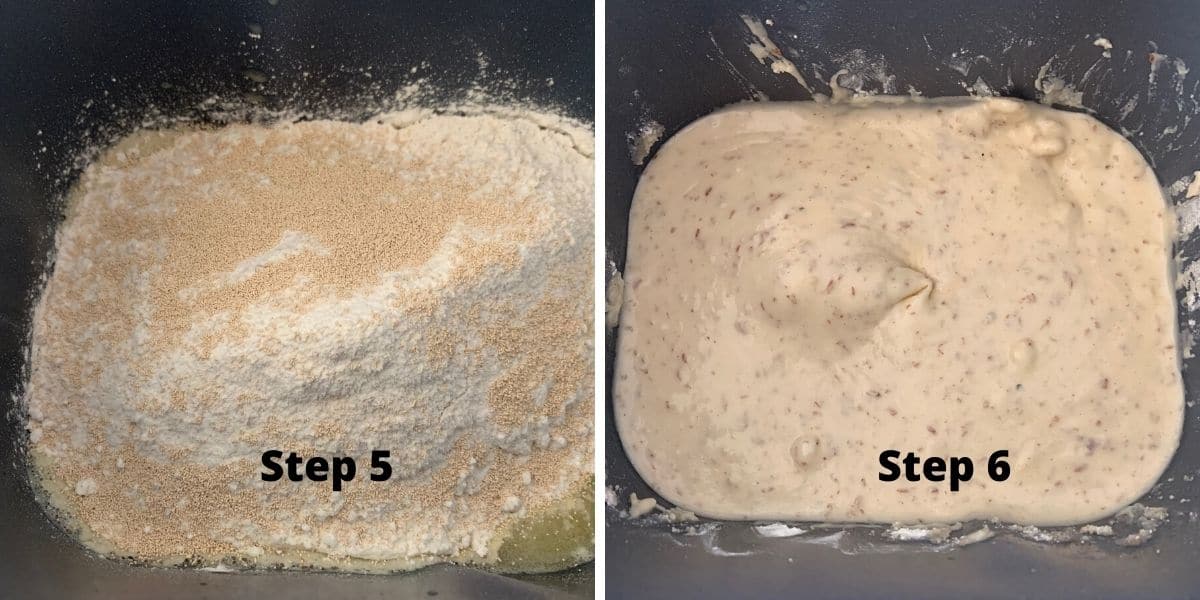
Step 5: Dump the yeast on top of the dry ingredients. Close the cover and press the button. My bread machine has a gluten free setting. If your bread machine has this setting, use it.
🔑 Sandi says: After 5 minutes, press the flour down from the sides with a soft rubber spatula. This tip will help prevent unmixed flour pockets on the side of your bread.
Step 6: This is what the batter looks like after the bread machine mixes the bread dough. You will see how wet this batter is compared to normal bread dough. This is what you want.
When the mixing has stopped, you can try to remove the paddle with the long pointy tongs I linked below or remove it when the bread is baked.
Step 7: Remove the bread from the bread machine when it is done. I gently slide my bread out of the pan and place it on a cooling rack. This helps prevent your bread from cooking longer in the hot pan.
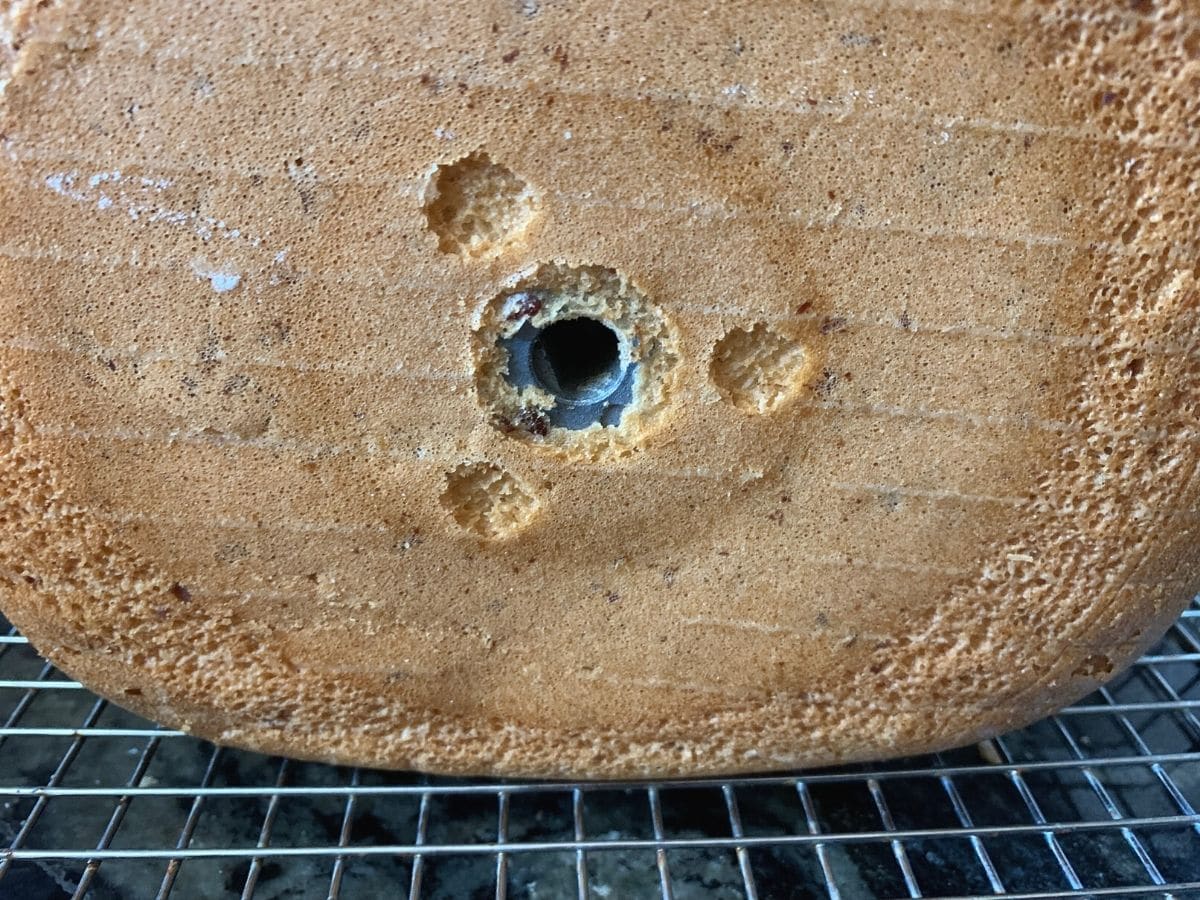
The only downside to using a bread machine is the little paddle comes off into your bread. The bread stays hot for some time, so I highly recommend you use tweezers or these pointed tongs to remove the paddle. It is easier to remove when the bread is hot.
Oven Baking Directions:
- Proof your yeast in ½ cup of warm water and 1 tablespoon of sugar. Make sure the water temperature is no hotter than 120º F. Let this sit for 5 minutes until your yeast is frothy.
- Follow the directions to mix your wet and dry ingredients.
- Add the frothy yeast mixture to the wet ingredients. Mix, then pour into the dry ingredients.
- Preheat the oven to 200º F, then turn off the oven.
- Mix your batter, pour it into a greased loaf pan, cover it with plastic wrap, and allow it to rise in the warm oven for one hour.
- Preheat the oven to 350º F.
- Bake your bread for 35-40 minutes until the top of the loaf is golden.
- Test to see if it is done baking by sticking a long toothpick into the middle. If the toothpick comes out clean, the bread is done baking. The bread must be baked a little longer if you see batter or crumbs.
- Remove the bread from the oven and place it on a rack to allow cooling. Do not slice the bread when it is hot.
Flavor Variations:
Feel free to vary the flavors you add to this gluten free bread machine bread. Here are some fun ways to do this:
- Add dried herbs and seasonings.
- When the mixing cycle has stopped, swirl in a combination of sugar and cinnamon.
- Add roasted garlic, butter, and shredded parmesan.
- If you are rice-free, try my Gluten Free Bread Without Rice Flour.
- Use this bread to make my popular Gluten Free Pumpkin French Toast Casserole recipe!
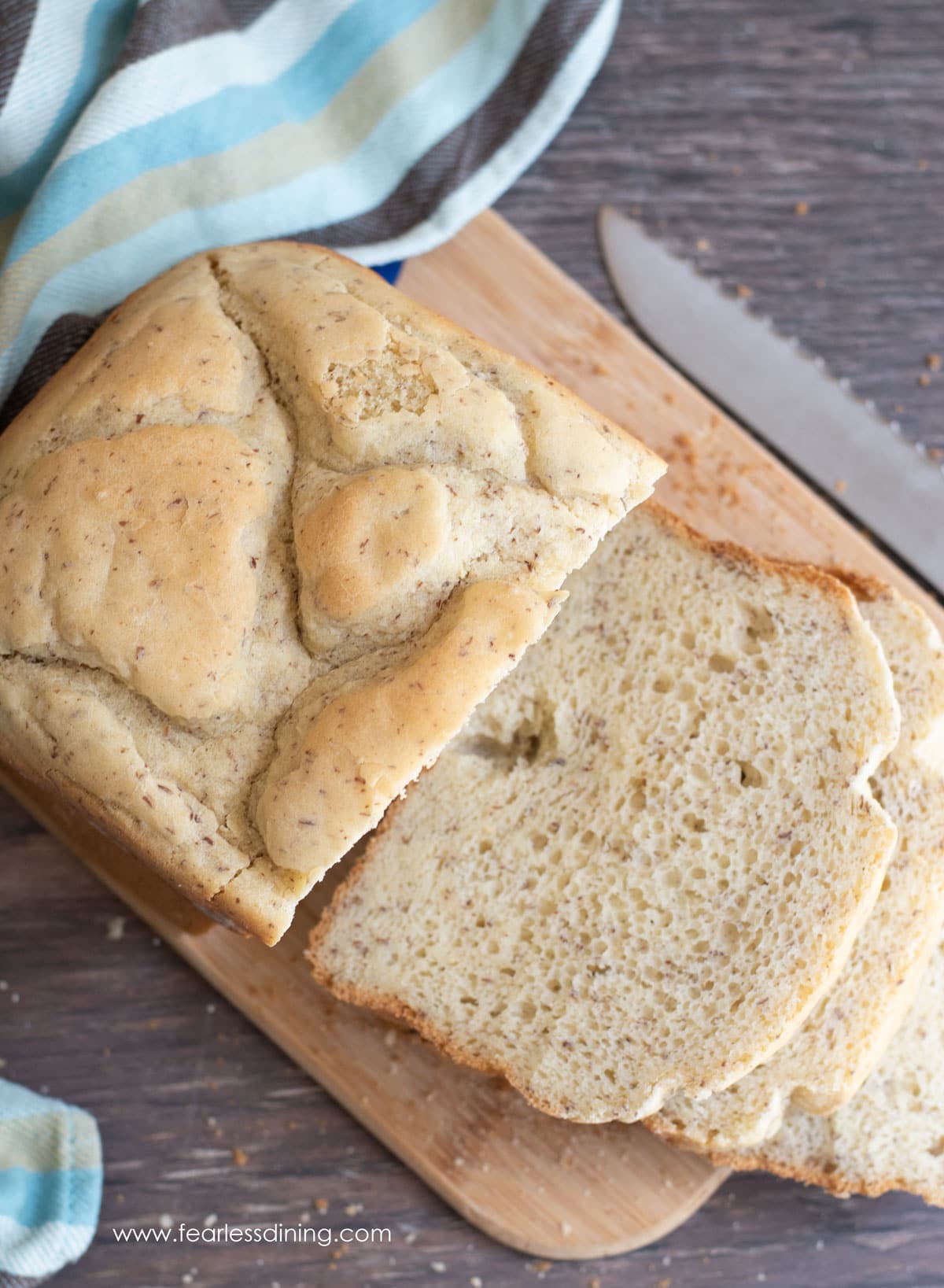
Recipe FAQ:
Store your freshly baked bread the right way! Learn How to Store Gluten Free Bread so you can keep it fresh.
Most yeast is gluten free EXCEPT Red Star Platinum. As always, definitely check the ingredients label for any yeast you buy.
I didn’t think a bread machine could make great bread for a long time, but this recipe has completely changed my mind.
Always put your wet ingredients into the bread machine first. It helps prevent flour pockets at the bottom of your bread loaf.
If you are using a bread machine, the baking time is automatic. To test for doneness, insert a toothpick into the center of the bread. If the toothpick comes out clean, it is done baking. If you see batter or crumbs, the bread must be baked longer.
If your bread didn’t fully cook and you did cook it on the gluten free setting, it may be the machine brand. You should be able to lengthen the bake time. See the above section titled Bread Machine Notes.
If you can’t have potato starch, use arrowroot starch to replace the potato starch.
This gluten free bread machine bread recipe makes a 1.5-pound loaf.
To make this recipe with Cup4Cup, omit the separate flours/ingredients listed: flaxseed, vinegar, and xanthan gum. Use 3 cups of Cup4Cup. Note I tested the original Cup4Cup and not their whole-grain blend in this recipe.
What bread machines are best for gluten free bread?
There are several great brands of gluten free bread machines that have a gluten free setting. My friend, Jane, who wrote The Gluten Free Bread Machine Cookbook, likes to recommend the Cuisinart CBK-200 machine. I have an old Breadman Pro, but I do not think they even make it any longer. Many in my gluten free FB group like this Hamilton Beach model.
More Gluten Free Bread Recipes:
- Gluten Free Bagels
- Gluten Free Crescent Rolls
- Easy Gluten Free Dinner Rolls
- Gluten Free Zucchini Bread
- The Best Gluten Free Breadsticks
- Gluten Free Naan
- Fluffy, sweet Gluten Free Hawaiian Bread
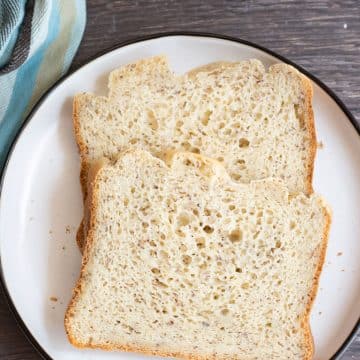
The Best Gluten Free Bread Machine Bread Recipe
Ingredients
- 1 cup sorghum flour 156.09 grams
- ½ cup brown rice flour 88.1 grams
- 1 cup tapioca starch 143.4 grams
- ½ cup potato starch 93.4 grams
- 2 tablespoons ground flaxseed meal
- 2 tablespoons sugar
- 1 teaspoon xanthan gum
- 1 teaspoon sea salt
- 1 teaspoon baking powder aluminum free
- 2 eggs size large
- ¼ cup light oil * see note
- 1 teaspoon apple cider vinegar
- 2 teaspoons yeast
- 1 ½ cups water * SEE NOTE
Instructions
- In a large bowl, add the dry ingredients and whisk to blend. In a smaller bowl, add your wet ingredients and blend.
- Open your bread machine and make sure the paddle is on the spinner. Pour in your mixed wet ingredients.
- Pour the whisked dry ingredients on top of the wet ingredients.
- Dump the yeast on top of the dry ingredients. Close the cover and press the button. My bread machine has a gluten free setting.
- If your bread machine has this setting, use it. After 5 minutes, take a soft rubber spatula and press the flour down from the sides. This tip will help prevent unmixed flour pockets on the side of your bread.
- Remove the bread from the bread machine when it is done. I gently slide my bread out of the pan and place it on a cooling rack. This helps prevent your bread from cooking longer in the hot pan.
- The only downside to using a bread machine is the little paddle comes off into your bread. The bread stays hot for some time so I highly recommend you using tweezers or these pointed tongs to remove the paddle. It is easier to remove when the bread is hot.
Notes
- Many bread recipe directions will say you can dump all of the ingredients in the bread maker. Do not do this! When you are mixing as many ingredients as is needed for gluten free bread, you risk the ingredients not getting mixed thoroughly, and that can affect how the bread turns out!
- Most yeast is gluten free EXCEPT Red Star Platinum. As always, definitely check the ingredients label for any yeast you buy.
- I always recommend using filtered water when making yeast bread. Chlorine in tap water can kill yeast.
- Light oils include avocado and canola oil. You can use other oils, but they may impart a flavor to the bread, which can be good or bad.
- To use Cup4Cup, add 3 cups Cup4Cup instead of the individual flour. Omit the xanthan gum, vinegar, and flaxseed.
- WATER – For some reason, some have had the middle cave, indicating there is too much water. Others don’t experience this. I am assuming it is the bread maker. If you notice the bread sinks in the middle, use 1 ¼ cups of water.
Oven Baking Instructions:
- Proof your yeast in ½ cup of warm water and 1 tablespoon of sugar. Make sure the water temperature is no hotter than 120º F. Let this sit 5 minutes until your yeast is frothy.
- Follow the directions to mix your wet and dry ingredients.
- Add the frothy yeast mixture to the wet ingredients. Mix, then pour into the dry ingredients.
- Mix your batter, pour it into a greased loaf pan, cover it with plastic wrap, and allow it to rise one hour.
- Preheat the oven to 350º F.
- Bake your bread for 35-40 minutes until the top of the loaf is golden.
- Test to see if it is done baking by sticking a long toothpick into the middle. If the toothpick comes out clean, the bread is done baking. If you see batter or crumbs, the bread needs to bake a little longer.
- Remove the bread from the oven and place it on a rack to allow cooling. Do not slice the bread when it is hot.
Breadmaker Issues:
Before I go into the recipe steps, I want to discuss breadmakers. This recipe depends on the bread machine you use and the cycle type you run. The gluten free time/cycle settings differ on EVERY machine and model number. I am not sure why this is, but I am noticing it. Here are things I noticed and some ideas:-
- If you are at a high altitude, your yeast may be much more explosive than at typical altitudes. I do not live at a high altitude and do not know what to do about this except to use less yeast and bake this bread in the oven.
-
- Some breadmakers do not have a gluten free cycle, or the programmed gluten free cycle isn’t long enough. If this is the case, use the “Home Made” custom cycle, programming in about: 20 minutes Mix, 45 minutes Rise, 90 minutes Bake.
-
- Often, the gluten free setting does not bake the bread long enough. If this happens, you can run a short “bake-only” cycle to brown the top of the bread more.
SPECIAL NOTE
Please know that every gluten free flour blend has a different starch to grain ratio. If you use a blend I didn’t test, you may need to adjust your moisture levels in your baked goods.
Nutrition
Nutrition Disclaimer
Nutritional information is an estimate provided to you as a courtesy. You should calculate the actual nutritional information with the products and brands you are using with your preferred nutritional calculator.

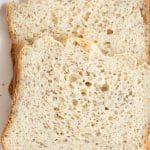
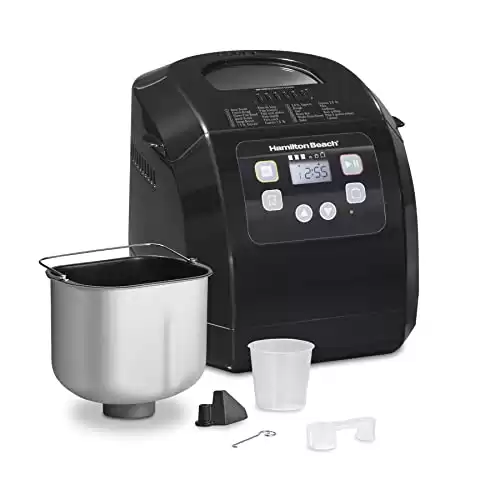
Couple questions..
1) For oven method, the recipe says 1.5 cups of water and 1/2 cup water for proofing yeast. Is that a total of 2 cups water for the whole recipe (oven cooked) OR is the total amount 1.5 cups water which is inclusive of the 1/2 cup needed for proofing yeast?
(I tried the recipe using 2 cups water but it was overly watery and bread was way too moist and took forever to cook. It tasted good though.)
2) Re: “Light Oil”. You mention seeing a note regarding the oil, but I’ve read the recipe at least 2-3x and can’t find the note. Can you please clarify what is considered a “light oil”?
(I used avocado oil)
Thanks.
Hi Dawne, You would want a total of 1.5 cups of water total. Light oil is something without a strong flavor. I use canola or avocado oil most for this bread.
Thanks for clarifying that. I’m looking forward to trying it again… with less water as you suggested.
I’ve tried the recipe 3 times now (oven baked) with the water amount you suggested. Yes… it worked better. Hubby loves it!!!
Also, since a packet of yeast is 2 1/4 tsp (recipe is 2 tsp) and I didn’t want to waste yeast, I added 12.5% more to the ingredients. Still worked great.
Last batch, I sprinkled some home-grown rosemary on the top. Yum!!
Hi Dawne, I m so glad you love this recipe and the rosemary sound lovely. I usually dump the whole packet in if I am using a packet.
I just made your bread recipe. The whole family just loves it. It is so soft and tastes better than store bought bread. Thank you for sharing your recipe.
You made my day coming back to let me know everyone loved it! Thank you!
I have an older bread machine and it doesn’t have the gluten-free button. What setting would be best to use? I am anxious to try this!
Hi Beth, Thank you for your note. I really am not sure what setting to recommend. You want to make sure the setting you choose doesn’t knead the dough endlessly as gluten free bread doesn’t need this. Try to find a cycle that has one mixing cycle.
Finally, a light & fluffy gluten-free bread machine bread that tastes wonderful!
I really want this to work. It rose to within 1/4” of the top of the bread pan – and then the center caved in to 1/2 the height. The crumb was still nice and fluffy and the crust was great too. The only modification I made to the recipe was to substitute aquafaba powder & water in place of the eggs.
My bread machine is a Cuisinart CBK-200.
Do you have any suggestions?
Thank you,
Steven Williams
Hi Steven, I am not familiar with aquafaba so I am not sure if that was it. Usually, if the bread rises way up, then caves it means the yeast activated causing it to rise too quickly. Did you use a packet of yeast? I am wondering if reducing the amount of yeast may help?
Hi Sandi,
I used 2 teaspoons of instant yeast. I had a thought – when I mixed the aquafaba powder with water to egg substitute, perhaps I added too much water. If the dough was too thin would that result in a sinking loaf?
Anyway, this bread was so good I want to try it again. Maybe next time I will use Bob’s Red Mill egg replacer instead.
Thanks,
Steven
Hi Steven, I don’t have experience with aquafaba as an egg substitute, but thin dough can definitely cause the loaf to sink. Keep us posted on your progress to make this recipe egg-free :-).
Amazing recipe!!!!! I am gluten sensitive and can’t do white flour. This was SO, so so good!!! Thank you! Keep up the great recipes!!!
I am truly glad this recipe helped you. You made my day coming to let me know.
Thank you for this great recipe. I have used your recipe with some substitutions bc of allergies.
I have replaced:
– the tapioca starch with arrowroot flour/starch (1 to 1);
– potato starch with cornstarch (1 to 1);
– sugar with monk fruit sweetener (1/3 monfruit for 1 sugar);
– Fleischmann’s yeast for bread maker.
The result was amazing. Very tasty firm enough to spread a nice pate). This is the first time we used a bread maker (Cuisinart CBK-200). We used the gluten free program. The bread raised nicely and cooked evenly. We will use this as our flour based for other kinds of bread.
I am so glad you loved the recipe and it is good to know monk fruit sweetener works well. I would love if you could give the recipe a star rating to help other readers if you have time.
I am wondering what kind of oil is best? Thank you in advance, Jen
Hi Jen, I used avocado, but canola will also work well. Thank you!
I have a bread machine but it has no GF setting.. just start as normal?
Hi Lin, I have never used a bread machine without the GF setting. I did a quick search and it seems you can use your machine, but make sure to pick the setting with only one mixing cycle.
Hi
Is there a way you can post the ingredients in grams? I tend to like weighing flours as it’s more accurate. Thanks!
My bread maker had 3 loaf sizes (2lb, 2.5lb, 3lb) Can I make a 3lb loaf with these ingredients or do I need to adjust anything?
My Breadman Pro machine is pretty old (around 2008). I tried to look it up and I think it is 2 lbs, which is what I based my recipe on.
Good information here, Thanks!
Thanks, Glenda, I am glad I can help you make homemade gluten free bread.
I didn’t have sorghum flour, so I used oat flour instead. I have an older two paddle Zojirushi breadmaker that is pretty reliable.
The resultant loaf had an excellent taste and texture – but the loaf sunk in the middle pretty severely.
I’m going to attempt this again, but I think I’m going to take out the baking powder and possibly substitute psyllium husk powder instead. I think it had too much lift – and that the yeast alone is fine. I buy the yeast in packets – so it tends to stay potent.
If it works – I’m wondering if I should enlarge the recipe to get a full 2 pound loaf. But first, I want to get a loaf that doesn’t sink.
Hi Adam, I haven’t used oat flour, but I do know it absorbs a bit more liquid than sorghum. I am not sure how that works in my recipe. Gluten free baking is so much like a science experiment. My loaf was pretty big, I am not sure the exact weight, but it made pretty large slices of bread in my machine.
I cut out the baking powder second time around. But still didn’t work. I have a habit of pre-heating the water (1 min in the micro) that also deviates – and could also be over-proofing the yeast. 20 years of GF baking – you get into habits that can mess things up with a new recipe. The problem is – it is just about the best tasting loaf I’ve made – even though it has a concave top. The texture and taste are amazing.
My Zoji is 20 years old – and doesn’t have a GF setting. But close enough. Might be an excuse to get a newer model!
LOL, my older Breadman is a good 10 years old. It isn’t perfect. I am glad you love the flavor of the bread. I am happy to help troubleshoot more. Here is my email, you can send me photos of the batter so I can see? also of the machine bread pan so I can see how deep etc.
Could you use one of the gluten free flour mixes? Perhaps Red Mill 1-1?
I only tested this with my blend as listed in the recipe, which worked amazingly well, and King Arthur Measure for Measure, which did not work.
This is a great recipe! It was heavenly eaten buttered and warm!
I am so glad you enjoyed it Wilhelmina. Thank you.
Great recipe for gluten free bread. Love it!
Thank you so much.
Can the rice flour be substituted with something else? Part of my diet is rice free. Thank!
Hi Eve, I haven’t tested any others, but I would think millet flour would work well as it is similar in texture to brown rice flour.